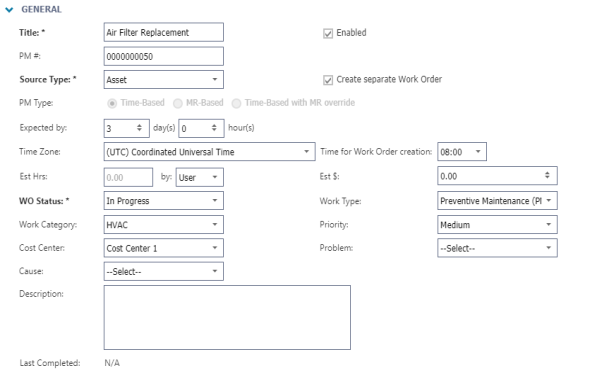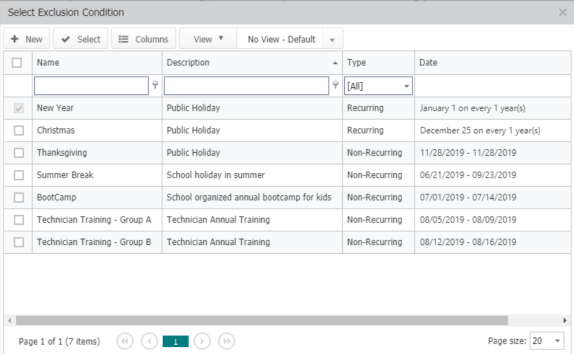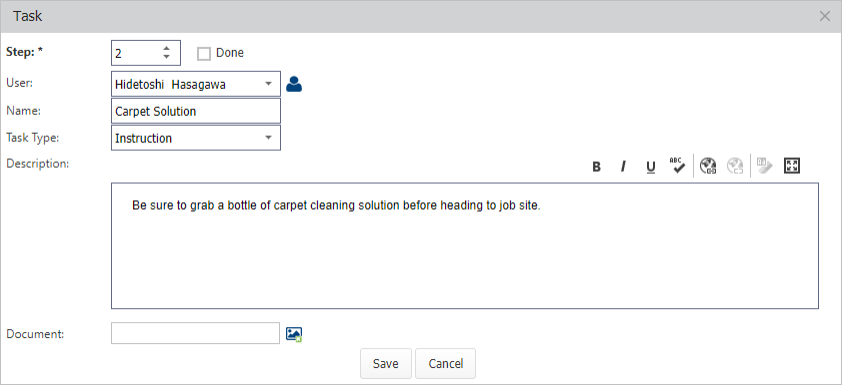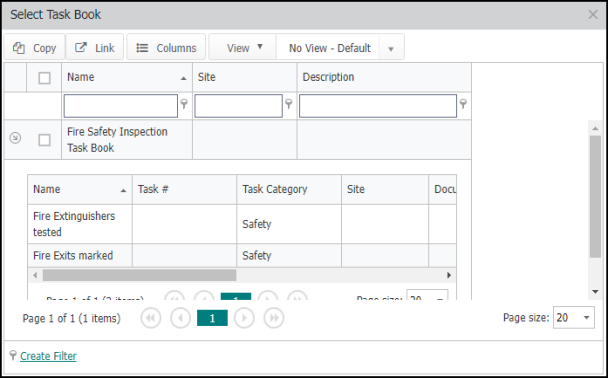Creating schedule based PMs
Asset Essentials allows you to generate new preventive maintenance (PM) work orders based on a set schedule.
Watch the video tutorial:
How to create a schedule based PM
- Click on the Work Orders menu icon, then click PM/PdM.
- Click the New button.
General
- Enter a Title.
- If this PM schedule should be active and ready to generate Work Orders upon saving, make sure the box next to Enabled is checked.
- Select the Source Type from the drop down menu.
- If you have selected the Asset Source Type, check the box next to Create separate Work Order if you would like a separate Work Order to generate for each individual Asset associated with this schedule.
- Select the Expected by day(s) and hour(s) to determine the amount of time it will take for the PM work order to be completed, starting from the Assigned date and time.
- Select the appropriate WO Status from the drop down menu.
The rest of the fields in the General section are optional, however it is recommended to provide as much detail as possible.

Schedule
- Select your frequency using one of the following options. The frequency settings will vary based on your selection.
- Daily - Select either Every (_) day(s) or Every weekday. Example: For work that needs to be done every day including weekends, enter Every (1) day.
- Weekly - Recur every (_) week(s) on (day(s) of the week). Example: For work that needs to take place every other Monday, enter Weekly - Recur every (2) weeks with a check mark in the box next to Monday.
- Monthly
- Day (_) of every (_) month(s) Example: For work that needs to take place on the 15th day of every month, enter Day (15) of every (1) month.
The (third) (Monday) of every (_) month(s) Example: For work that needs to be done on the first weekday of every quarter, enter the (first) (weekday) of every (3) months.
- Yearly - Every (_) Year(s)
- (January) (_) Example: For work that needs to take place on October 15th of every year, enter (October) (15) and Every (1) Years.
The (first) (Monday) of (January). Example: For work that will be done on the first weekday in May every other year, enter The (first) (weekday) of (May) and Every (2) Years.
- The default Start date for this PM schedule is today's date. This date can be adjusted if needed.
If you have PM work that needs to be performed only during a specific time of year, you can setup a seasonal start and end date between which the above selected frequency will apply. This option provides an alternate way of producing work orders during just the season where they are applicable, and prevents the need to enable and disable PMs every year.
- Choose the Season starts option.
- Select the month and day from the drop down menu for the Season start and end dates.
Select the Don't create WO unless the prior ones from this PM have been completed option to prevent recurring work orders from being generated unless the previous work order has been completed. This is useful for daily or weekly tasks. For example, a PM schedule to inspect a generator on a daily basis should not create a work order unless the generator was inspected the day before.
- Choose whether this setting should apply to This PM only or another Selected PM/PdM.
Site/Location/Asset
The Source Type you selected in the General section will determine what field this section is dedicated to.
- Select the specific Site(s), Location(s), or Asset(s) the PM work is for.
Exclusion conditions
You can use this section to apply PM Exclusion Conditions created at the account level or the site level in order to halt PM work order generation for a specific amount of time.
- To apply all active site level PM Exclusion Conditions, check the Apply site level exclusions box. A grid will display including all active PM Exclusion Conditions that will be applied to this PM. *Note: If the PM has multiple sites, then this option will be disabled.

- To apply specific PM Exclusion Conditions to the PM, check the Apply PM level exclusions box.
- Click the Select Exclusion Condition icon (
).
- Check the box next to the PM Exclusion Condition(s) you would like to apply to this PM.
- Click Select at the top of the window.
- Click Save at the top of the page.
- Click OK in the confirmation window that appears to finalize your changes.

- Choose from the following two options in the To generate WO section:
- on next scheduled date (skip this cycle): The next PM work order generation will take place on the next scheduled cycle after the PM Exclusion Condition date has passed.
- on next work day: The next PM work order generation will take place on the next day, including weekends, that does not include any exclusions.
- Click Save at the top of the page.
Work requested
The Work requested section provides a way to enter a description of the work to be performed. In general, this description is an overview of the work, and does not replace the Tasks/Steps section of the PM.
Assigned to
Use this section to indicate who is responsible for the PM work.
- Click the Select User (
) or Select Me (
) icons to either select yourself or another user whose information is already populated in Asset Essentials.
Parts
The Parts section of a PM schedule enables you to allocate or assign parts to a PM. Those parts will appear on each work order that the PM schedule generates. This creates a link between parts assigned in the PM and the inventory held by the organization.
- Click on the Select Part icon (
).
- Choose the Part(s) from the Select Part window.
- Enter the Quantity needed for the PM.
- Select a Usage Type.
- Dispatch: This option will subtract the Quantity listed from the current Quantity Available for the part when a work order is generated.
- Reserve: This option will mark the Quantity listed as Reserved Quantity for the part when a work order is generated.
- Order: This option will create a parts transaction for parts that need to be ordered when a work order is generated.
- Select a Usage Option.
- Manual: This option does not automatically add parts to the work order when it is generated. Any parts needed for the work order will need to be manually added.
- First Available: This option adds parts to the work order from the first available location.
- Preferred Order: This option adds parts to the work order from the preferred location.
- Enter a description of the part, if needed.

Equipment
An asset needed to complete PM work is defined as a piece of equipment and can be added to the PM schedule as an equipment item. For example, if you need to use a Shop-Vac to complete the PM work, you can select the Shop-Vac asset in this section to indicate it will be used to on the job. If you are performing maintenance on the Shop-Vac, then it would be selected as an Asset on the PM Schedule and not in this section.
- To select a piece of Equipment, click the Select Asset icon (
).
- In the Select Asset window, check the box next to the Asset(s) you will be using as Equipment, and click the Select button.
- Select the User who will be using the Equipment to complete this PM work.
- If the Equipment has an Equipment Rate, select it from the drop down.
- If you are utilizing the Calendar features of Asset Essentials, enter a Start Time and End Time so other staff members can view when the Equipment will be in use.

Tasks/Steps
Asset Essentials allows you to create a list of tasks for the worker to follow. You have the option to either create a new task by clicking the Add New Task button or you can select a existing task from the Tasks Library. *Note: If you are adding a task to a new PM or work order, you must first save the PM or work order before any tasks can be added.
Task types
There are 3 task types to choose from when creating tasks on your PMs:
Instruction - use this task type for generic step-by-step tasks
Collect Reading - use this task type if the worker should record any meter readings from an asset. *Note: If you select Collect Reading, you must also select an Asset and a Meter Title.
Pass/Fail - use this task type for inspection-like tasks that require a determination that an asset passed a review, failed a review, or failed the review but was able to be fixed. *Note: If you select Pass/Fail, you must also select an Asset.
Adding a task from the tasks library
- Click on Select Task from library.
- Check the box next to any task you would like included on the work order.
- Click the Copy or Link button to transfer the tasks to the PM schedule.
- Copy: The Copy button will allow you to make edits to the tasks on the individual PM without altering the original task stored in the library.
- Link: The Link button will gray out the tasks on the individual PM and not allow you to make edits. In order to make edits using the Link button the tasks must be edited directly from the task library and will affect all other PMs that have those tasks linked.
Adding a task book from the tasks library
- Click on Select from library, then click Select Task Book.
- Check the box next to each task book you would like to add to the PM and click the Copy or Link button. *Note: If you need to preview the tasks included, click the arrow icon (
) next to the task book.
- Copy: The Copy button will allow you to make a copy of all the tasks in the task book onto the individual PM. Once copied, the tasks are no longer associated with the task book and can be edited without altering the original tasks stored in the library.
- Link: The Link button will gray out the tasks on the individual PM and not allow you to make edits. In order to make edits using the Link button, the tasks must be edited directly from the task library and will affect all other PMs that have those tasks linked.
- The tasks will now appear on the PM. *Note: When a work order generates from the PM the Task Book name will not be displayed on the work order but the tasks within the Task Book will still be listed in the correct order.
Adding a single task
- Click on Add New Task to create a new task on the work order.
- In the Task window, select the User responsible for the task from the drop down menu or click the user icon (
) to select a user from the list.
- Enter the Name of the task as well as the Description.
- Select the Task Type.
- Instruction - generic step-by-step tasks
- Collect Reading - when meter readings need to be recorded for an asset. *Note: You must also select an Asset and a Meter Title with this task type.
- Pass/Fail - for inspection-like tasks that require a determination that an asset passed a review, failed a review, or failed the review but was able to be fixed. *Note: You must also select an Asset with this task type.
- Enter a Description for the task.
- If you need to attach a document to the task, click the image icon and select a document from either your Document Library or upload a file from your computer.
- Repeat these steps to add as many tasks as needed.

Documents
Use this section to attach documents related to your PM schedule.
- Click on the Select Document icon to either select a document from the Documents Library, or add a document from your computer.
Custom fields for work order
If your account is using custom fields, fill out any information in this section.
- Once you have completed all of the required fields, click the Save button at the top of the page.


